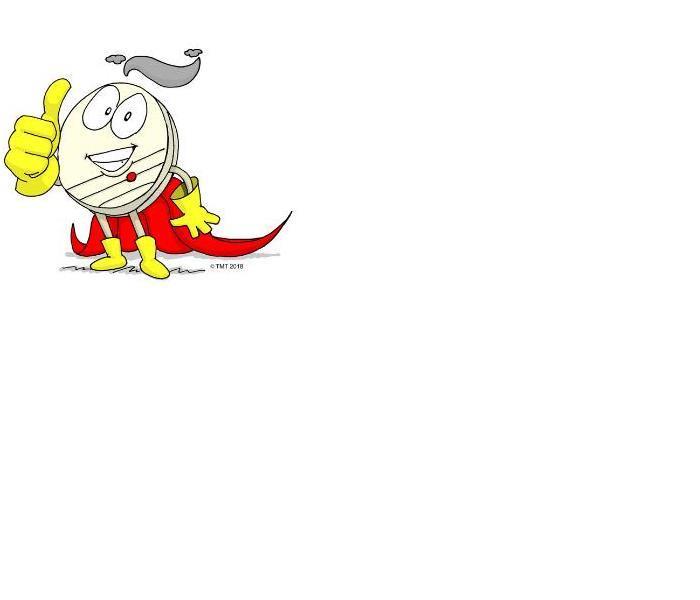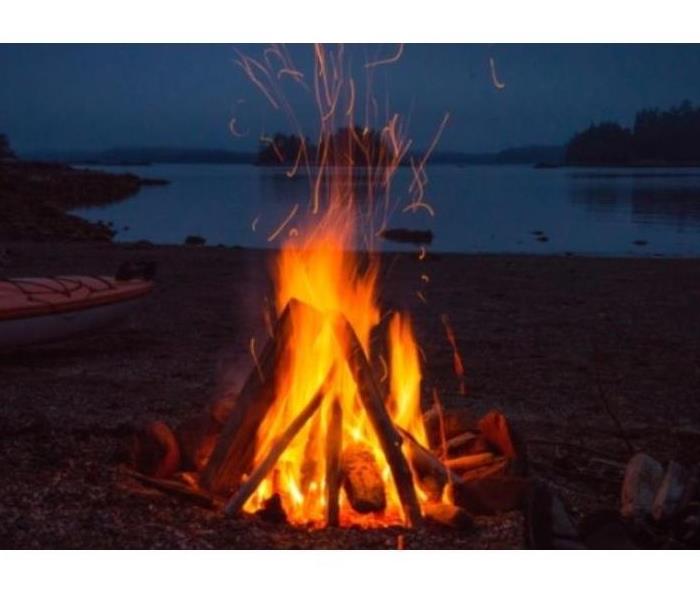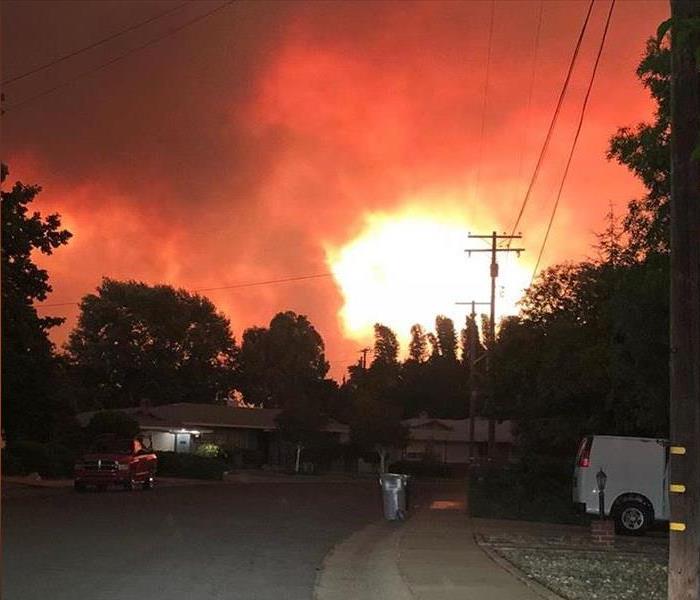Recent Fire Damage Posts
Once you’ve had a fire
6/28/2022 (Permalink)
SERVPRO of Benicia/ Martinez/ Southeast Vallejo is here to help. 925/372-7234
After a house fire is put out, the smoke has cleared, the fire department is gone, you are left with a disaster on your hands. In the aftermath of a fire–no matter how big or small–it’s imperative to know what to do and what to avoid doing.
In the first few hours and days after a fire, your home will likely suffer from extensive fire and smoke damage, as well as water damage. During this time, it’s best to hire a professional restoration company to thoroughly handle the restoration process. You certainly don’t want to cause further damage or worsen the already-devastating situation! SERVPRO can assist with restoring salvageable damaged possessions and getting your property back to preloss condition. “Like it never even happened” is not just a slogan it’s what we do. Give us a call at 925-372-7234 today.
Fire- At home tips
6/22/2022 (Permalink)
SERVPRO of Benicia/ Martinez/ Southeast Vallejo is here to help. 925/372-7234
Just a couple quick things that could really help in preventing a house fire
Install smoke alarms on every floor of the house and in every bedroom. Test the alarms at least once a month and change the batteries as needed.
Have an approved and functional fire extinguisher in the kitchen.
Have a plan of evacuation and teach kids what to do if there is a fire. Have backup plans in case the fire blocks the primary route or exit.
Practice fire drills periodically with the whole family.
The best way to avoid a fire in the home is to take action towards preventing one. Follow the prevention measures mentioned above. The next best thing to do is to be prepared if there is a fire in the home. Having a plan and practicing that plan can keep your family safe during a fire situation. These safety measures may save your life or one of your family members in the future.
Fire Safety Tips
6/6/2022 (Permalink)
SERVPRO of Benicia/Martinez/Southeast Vallejo will be there if you need us 925/372-7234
- Maintain your fireplace correctly.
- Inspect the fire box (hearth) for cracks, damaged sheet metal (for inserts) and other hazards.
- Use glass fire doors or a wire mesh spark screen to prevent embers from popping out of the fireplace.
- Burn dry, seasoned wood to prevent creosote buildup in the chimney. Note that some woods, like cedar, pop excessively when burned, and should not be used in an open fireplace.
- Remove ash and unscorched wood only when there are no embers or sparks in the fire box. Place ash in a metal (not a plastic bucket) and place outside away from any buildings.
- Have your chimney inspected and cleaned at least once a year.
- Keep flammable liquids away from ignition sources.
- Keep gasoline, paint thinners, and other highly flammable liquids or materials in UL approved containers and out of the house.
- Do not store any flammable liquid in a garage or utility room with that has a pilot light equipped appliance in use in it. Be safe, keep these items outdoors, or in a separate outbuilding.
At home in the Kitchen
6/2/2022 (Permalink)
SERVPRO of Benicia/Martinez/Southeast Vallejo will be there if you need us 925/372-7234
Stay in the kitchen when using the range for cooking. If you are leaving for just a minute, turn off all the burners on the range. Going to the basement for a can of tomatoes, or running out to check the mail, going to the bathroom, answering the phone in another part of the house? Simply turn off all the burners. After all, you are just leaving for a minute. You can immediately turn the pot or frying pan back on when you return. Taking this simple step will prevent one of the most common situations that cause house fires: unattended cooking.
When cooking with oil, keep a lid or flat cookie sheet close by. If flames appear, simply suffocate the fire with the lid and immediately turn off the stove or fryer to let it cool down. Do not try to move the pan. Do not use water. The super-heated water will explode into steam, and can cause severe burns, and oil can splash and spread the fire.
Check the safety of appliances
6/1/2022 (Permalink)
If a fire does happen we are here to help 24hrs a day.
SERVPRO of Benicia/Martinez/Southeast Vallejo 925/372-7234
Two things to keep an eye on
Keep your stove and oven clean, especially watching for grease accumulation.
Check stove vent hoods, clean the filter regularly, and make sure that if it is equipped with an exterior vent, insects or birds do not build nests or otherwise impede the air flow through it.
Check the power cords for your appliances. Look for missing grounding prongs on the plugs and damaged insulation, and replace or repair them if defects are found.
Keep the lint trap and outside vent clean in your clothes dryer. Some dryers have internal ductwork which may become clogged and require servicing, so if the dryer is operating poorly, have it checked. Lint or other material collecting near the heat coils in clothes dryers is extremely dangerous. Stay nearby while using the dryer. Have a smoke alarm and fire extinguisher nearby. If you must leave the area for a minute, turn off the dryer. After all, you are not going to be away long, and you can immediately turn the dryer on when you return.
Safety in the Home
5/25/2022 (Permalink)
SERVPRO of Benicia/Martinez/Southeast Vallejo 925-372-7234
Be very careful with space heaters.
Keep flammable materials (curtains, the couch) a safe distance (usually 3 feet) from portable heaters.
Set heaters where they are not in the traffic flow of the room.
As a rule, extension cords are not recommended with space heaters. Small, low wattage heaters may be an exception, but check the manufacturer's recommendations prior to using an extension cord with one. Be safe, just don't use extension cords.
Use space heaters only on solid, firm surfaces. They should never be placed on tables, chairs or other places where they may tip over. Replace old space heaters with ones that will automatically turn off if tipped over.
Do not drape fabric over lamps to dim them. Either buy a lower wattage bulb, or turn the lamp off.
Smoke Alarms
4/29/2021 (Permalink)
In general, there are two types of smoke detectors used in homes: photoelectric and ionization. Each one senses smoke differently.
The type of smoke produced by a fire depends on the type of fire. Flaming fires produce a different type of smoke than smoldering fires.
Both types of alarms will detect the smoke from either a smoldering fire or a flaming fire.
Ionization smoke alarms tend to respond faster to the smoke produced by flaming fires than photoelectric smoke alarms.
Photoelectric smoke alarms tend to respond faster to the smoke produced by smoldering fires than ionization smoke alarms.
Having working smoke detectors in the home is the most important, whether they be photoelectric, ionization or dual sensor alarms which contain both sensors.
SERVPRO of Benicia/Martinez/Southeast Vallejo 925-372-7234
Fireplace Safety Tips
1/8/2021 (Permalink)
?
? Many people rely on a fireplace or wood burning stove to heat their home. Here are some tips for using your fireplace safely.
- If possible, keep a window cracked open while the fire is burning.
- Be certain the damper or flue is open before starting a fire. The damper can be checked by looking up into the chimney with a flashlight or mirror.
- Use dry and well-aged wood. Wet or green wood causes more smoke and contributes to soot buildup in the chimney. Dried wood burns with less smoke and burns more evenly,
- Clean out ashes from previous fires. Levels of ash at the base of the fireplace should be kept to 1 inch or less because a thicker layer restricts the air supply to logs, resulting in more smoke.
- The chimney should be checked annually by a professional.
- Even if the chimney is not due for cleaning, it is important to check for animal nests or other blockages that could prevent smoke from escaping.
- Safety screens should be used.
- Make sure the area around the fireplace is clear of anything that is potentially flammable.
- Never leave a fire in the fireplace unattended. Make sure it is completely out before going to bed or leaving the house.
- Install both smoke and carbon monoxide detectors. Test them monthly and change the batteries at least once a year.
- Keep a fire extinguisher on hand.
SERVPRO of Benicia/Martinez/Southeast Vallejo is here to help with any fire or smoke damage caused by your fireplace. Give us a call at 925-372-7234
Prevent Chimney Fires
1/8/2021 (Permalink)
There are more than 25,000 chimney fires incurring $125 million-plus in property damage every year in the United States. In the most severe cases, chimney fires can destroy houses and put lives at risk. These tragedies are often preventable.
Fortunately, if you practice the prevention tips here your family should be able to enjoy a nice cozy fire on those chilly days.
Have your chimney inspected yearly and cleaned by a professional when recommended.
Install a chimney cap. This will help prevent debris entering the flue and also help with preventing the smoke from re-entering.
Burn seasoned wood to help prevent the build up of creosote in the chimney.
Burn large logs, rather than many smaller logs and never burn cardboard or wrapping paper.
SERVPRO of Benicia/Martinez/Southeast Vallejo is here to help. Give us a call at 925-372-7234
Not all fires are the same!
4/13/2020 (Permalink)
Not all fires result in the same level of damage. Subsequently not all fire damages require the same type of restoration.
Any particular loss could involve a range of damages from minor to major.
We categorize the levels of fire damage to 3 different categories: By categorizing the type of loss, we can provide you an idea of the restoration services required to address your level of loss.
Minor Fire Damage. Smoke residues affect only certain rooms or areas. The amount of smoke residues is light to moderate. Restoration may involve dry cleaning and/or wet cleaning of ceilings, walls, floors, and contents.
Medium Fire Damage. The amount of smoke residues is moderate, and more materials require wet cleaning to remove residues. The number of areas requiring repainting and items requiring replacement increase. Floors may need to be refinished. Heat damage to drywall, cabinets, and contents requires more materials to be replaced. Contents might be cleaned at the jobsite. Smoke odors are noticeable, possibly requiring additional deodorization procedures after cleaning.
Major Fire Damage. Fire and heat damage is severe near the source of the fire. Structural framing and finishes may be charred, requiring structural repairs. Smoke residues are distributed through a large portion of the building, and smoke odors are strong and possibly pungent. Emergency services might be needed, such as boarding up the structure, establishing a source of electricity, winterizing the building in cold weather, and removing smoke-filled and charred debris. Restoration will most likely involve extensive cleaning of the structure and probably require restorers to pack and move out all salvageable contents for off-site cleaning. Multiple methods of deodorization are needed to remove smoke odors.
Call SERVPRO of Benicia/Martinez/Southeast Vallejo to schedule an appointment to assess your Fire damage today. Our staff is highly trained in Fire Damage restoration and can help ease your distress during this traumatic experience.
Can my belongings be cleaned?
1/18/2020 (Permalink)
Fire damage doesn’t always mean your belongings are destroyed. In fact, SERVPRO can restore a lot of smoke damaged items. There are several factors that go into whether or not an item can be cleaned. Some of them are:
- Type of material burned. Synthetic materials tend to create a wetter residue that can cause staining, while natural materials (like wools) create a drier residue that is much easier to clean.
- Air pressure. Hot air expands and creates air pressure. That pressure can push soot and residue deep into cracks and crevices, effectively making it harder to clean.
- Temperature change. If residues contain hot oils that are cooled too fast can create a film on your surfaces that is hard to clean off.
- Amount of moisture. Moisture or water can actually make residues set and there is more of a chance of staining on your surfaces. Damp weather can actually cause this as well.
Types of Smoke Residue
1/13/2020 (Permalink)
Did you know there are different types of smoke residue? There are in fact four different types, and each type needs to be handled in different ways.
- Dry smoke residues
- Wet smoke residues
- Protein smoke residues
- Fuel oil smoke residues
Some things that factor into what makes the residue dry or wet.
- The rate of combustion
- The amount of oxygen present during the fire
- The type of material or substance that is burning
So, what is the difference between wet smoke and dry smoke?
Fast-burning, oxygen rich fires tend to produce a dry smoke, while oxygen-starved, slow burning fires produce a wet smoke. Typically, natural materials that burn make a dry smoke and synthetic materials make a wet smoke.
Materials are generally more restorable when involved in a dry smoke loss. It will not stain surfaces as deeply like a wet smoke will. The problem though is that a dry smoke comes with a hotter fire, meaning that there is probably more heat damage.
Can this be cleaned?
1/13/2020 (Permalink)
Fire damage doesn’t always mean your belongings are destroyed. In fact, SERVPRO can restore a lot of smoke damaged items. There are several factors that go into whether or not an item can be cleaned. Some of them are:
- Type of surface. If a surface is nonporous, like vinyl or glossy paint, it will be much easier to clean compared to a more porous surface. A porous surface allows for odors and particles to get down deep.
- Amount of heat. As well as heat charring or melting materials, it can also cause materials to become more porous and make it harder to clean.
- Amount of moisture. The water used to put a fire out can actually cause residue to set and there is a greater chance of the material staining.
- Age of surface. The older the surface, the harder it is to clean. This is due to age deteriorating and item and making it porous and weaker.
Importance of Smoke Alarms
8/14/2019 (Permalink)
Smoke alarms are a key part of a home fire escape plan. When there is fire, smoke spreads fast. Working smoke alarms give you early warning so you can get outside quickly.
Smoke Alarm Tips:
- Install smoke alarms in every bedroom. They should also be outside each sleeping area and on every level of the home. Install alarms in the basement.
- Large homes may need extra smoke alarms.
- It is best to use interconnected smoke alarms. When one alarm sounds, they all sound.
- Test all smoke alarms at least once a month. Press the test button to be sure the alarm is working.
- There are two kinds of alarms. Ionization smoke alarms are quicker to warn about flaming fires. Photoelectric alarms are quicker to warn about smoldering fires. It is best to use both types of alarms in the home.
- A smoke alarm should be on the ceiling or high on a wall. Keep smoke alarms away from the kitchen to reduce false alarms. They should be at least 10 feet from the stove.
- People who are hard of hearing or deaf can use special alarms. These alarms have strobe lights and bed shakers.
- Replace all smoke alarms when they are 10 years old.
Hauling Debris
8/7/2019 (Permalink)
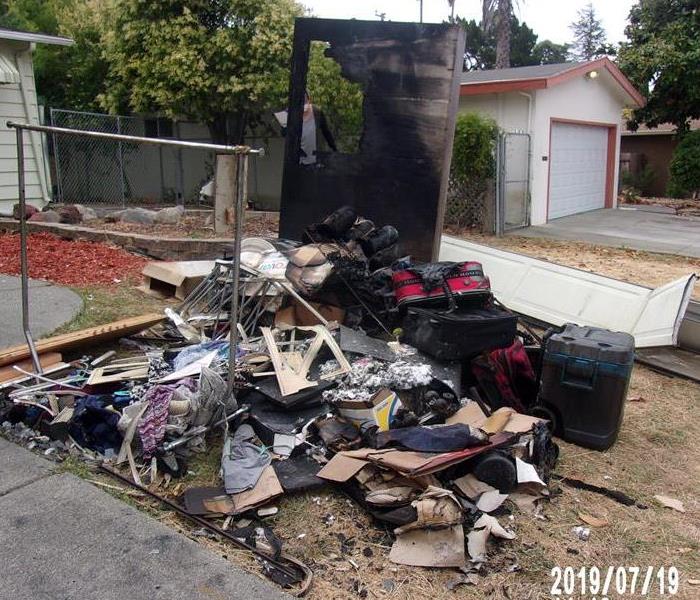 Don't stress, call us today and let us take care of the mess!
Don't stress, call us today and let us take care of the mess!
When your home falls victim to a fire, depending on how long the fire went on and how quickly it was put out, you could lose a lot of your contents.
If you don't have the proper help, getting rid of those contents on your own can be tough and a lot of work. Not to mention, very time consuming and stressful.
Well, we are happy to let you know that we here at SERVPRO Benicia/Martinez/SE Vallejo offer services to help you with that. We are equipped with the staff, tools, and vehicles to help haul all of the debris and non salvageable items out and away from your home.
We will handle the labor, the hauling, and the dumping so you can deal with more important matters.
Campfire Safety
4/2/2019 (Permalink)
With Summer around the corner, we all know that camping is on most of our to do lists. Campfire accidents send thousands of people to emergency rooms with burn injuries every year. So, we wanted to go over some tips to stay safe during campfires:
- Before setting up a campfire, be sure it is permitted.
- Keep campfires at least 25 feet away from anything that can burn.
- Clear away dry leaves and sticks.
- Avoid burning on windy days.
- Watch children while fire is burning.
- Attend to the campfire at all times.
- Keep a campfire small which is easier to control.
- Never use gas or other flammable or combustible liquids.
- Always have a hose, bucket of water, or shovel nearby to put out the fire.
- If your clothes catch fire, stop, drop, and roll.
- Treat burns right away. Cool the burn with cool water for 3 to 5 minutes. Cover with clean, dry cloth. get medical help if needed.
Space Heater Safety
1/10/2019 (Permalink)
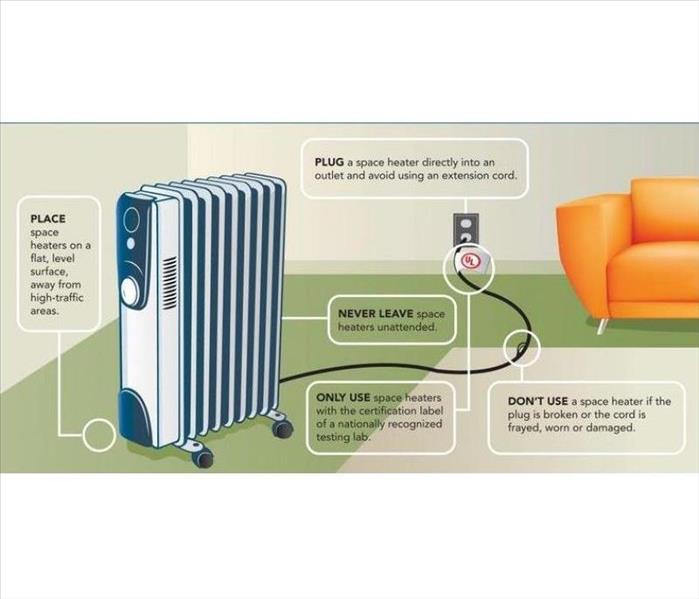 A little space heater can do a lot of damage so practice these safety tips to prevent a fire from starting.
A little space heater can do a lot of damage so practice these safety tips to prevent a fire from starting.
Now that it is officially Winter time, we can definitely feel it! Because of that, most of us are bundled up, using our heaters and what not to keep us warm. One thing a lot of us use is space heaters as they are a convenient source of heat for your home or work space. What we all need to know and stay cautious of about these electric space heaters is that they are the second leading cause of fires in a home or office. These fires result in hundreds of deaths, thousands of injuries, and millions of dollars in property damage. So, don't be the next victim of a space heater fire. Follow these helpful tips to prevent that from happening:
- Make sure your space heater is properly plugged in and away from any combustibles.
- Always read the manufacturer’s warning labels and instructions carefully.
- Do not use heater if there are any frayed, worn, or damaged signs on the plug.
- Make sure the heater is kept at least 3 feet away from anything that can burn such as papers, clothing, and rugs.
- Do not place the space heater in a high traffic area where it may pose a tripping hazard.
- Plug space heater into wall outlets, avoid plugging them into extension cords or power strips as they could overheat and start a fire.
- Always place heater on a level, flat surface. Never place them on cabinets, tables, furniture, or carpet.
- Never leave the space heater unattended while on, always turn off, unplug and safely store when not in use.
Wildfires In California 2018
11/16/2018 (Permalink)
As most of you know, this year has been one of the worst years in California's history when it comes to wildfires. There have been over 7500 fires that have burned over 1.6 million acres throughout our Golden State. According to the California Department of Forestry and Fire Protection, that is the largest amount of burned acreage recorded in a fire season. The most recent wildfires going on (Camp Fire, Woolsey Fire, and Morgan Fire) have filled the skies with thick gray smoke and our hearts with sorrow for those who have lost everything if not their own lives. This is a sad time in California, but the best time for us to show that we can come together and be there for each other in times like these. Whether it's time or donations, let's all work together to give back to those less fortunate. Look into how you can help today.
Home Fire Sprinklers
11/1/2018 (Permalink)
Over 80% of fire deaths occur in the home. Home fire sprinklers can save lives and property from fire.They respond quickly and effectively to fire, often extinguishing the fire before the fire department arrives. Only the sprinkler closest to the fire will activate, spraying water on the fire.
SAFETY TIPS
- Home fire sprinklers save lives and property. In many situations, a family who has survived a fire will also have their “home” to live in and enough of the items and space in their home to continue living their lives as they did before.
- The cost of a home fire sprinkler system in a new home averages $1.35 per sprinklered square foot totaling an amount similar to what is spent for carpet upgrades, paving stone driveway or a whirlpool bath.
- A home fire sprinkler system can reduce the homeowner’s insurance premium.
- Fire departments typically use roughly 10 times as much water as a fire sprinkler would use to contain a fire.
- Fire sprinklers are environmentally friendly. They can reduce the amount of water run-off and pollution, fire damage by up to 71%, and water usage to fight a home fire by as much as 91%.
- Cigar smoke or burnt toast will not activate a fire sprinkler. Only the high temperature of a fire will activate the sprinkler.
- A home fire sprinkler system is easy to maintain. Just inspect your home to make sure the sprinklers are not blocked by something that would prevent the water from coming out such as paint and be sure the main control valve is never turned off.
- Home fire sprinklers are effective in cold and warm climates. Guidelines have been created for the proper installation of systems to avoid pipes freezing. A home fire sprinkler system should be winterized the same as you winterize a domestic water supply.
Contents
9/25/2018 (Permalink)
 Let us help you restore your home and contents to make it "Like it never even happened"
Let us help you restore your home and contents to make it "Like it never even happened"
When a home catches fire, the firemen usually get there to salvage a majority of the house. But what do you do once the fire is out and you are left with smoke and soot damaged contents?
Well I am happy to say we are only one call away!Let SERVPRO of Benicia/Martinez/SE Vallejo handle it.
We can pack out all of your salvageable and non-salvageable items. We will load up, haul, and dump the non-salvaged items. All that is salvageable will be taken off site to our offices, cleaned, and deodorized. We even offer storage for your items, so if you are not ready for it all to come back , that is no problem! We will store it for you until you are ready for us to deliver it back.
We know how hard it is to let go of contents that are sentimental and hold meaning. So let us do our best to bring those items back to life!
The Aftermath of a Wild Fire
8/30/2018 (Permalink)
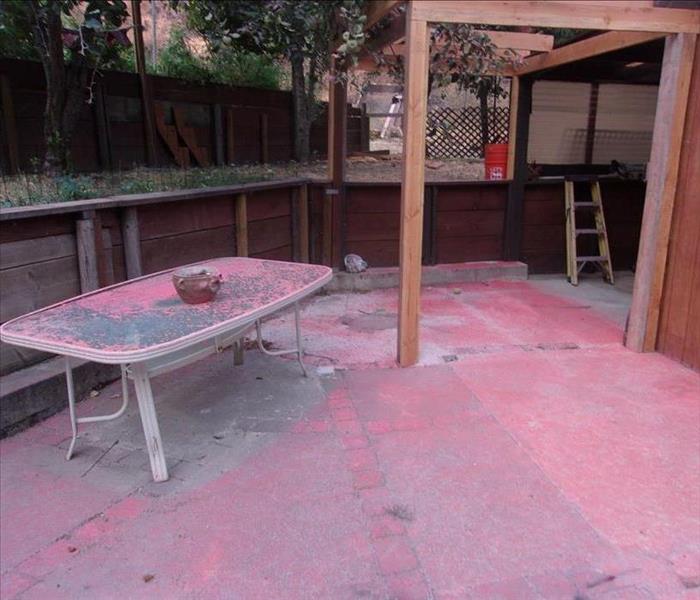 Notice all the red residue.That is the retardant used by fire fighters to put the flames out.
Notice all the red residue.That is the retardant used by fire fighters to put the flames out.
Greetings from SERVPRO Benicia/Martinez/SE Vallejo! As most of you know, the most recent wild fire in California known as The Carr Fire destroyed so much. The fire burned approximately 229,651 acres , caused about 38,000 people to evacuate ,and destroyed around 1,604 structures. At least 1,077 of those structures were homes. All SERVPROs in California were ready to hit the road and help restore any structures that needed us. In the photo above, the owners were lucky to only need a cleaning done for all the fire retardant left behind from the firefighters putting out the fire on a hill very close to their home. We took pride in helping the owners get their yard and contents restored and looking good as new! Like it never even happened.
Fire Safety Tips
8/2/2018 (Permalink)
With all the wild fires California has had this year and continues to have, we here at SERVPRO Benicia/Martinez/SE Vallejo would like to offer some tips on how to keep safe from fires should it ever occur in your home, business, or area.
Keeping Safe in Your House or Job
You should always react as soon as you hear your smoke alarm goes off due to a fire. Quickly notify everyone in your home or job building and get out. Don’t worry about grabbing any items such as valuables or important possessions, materials are replaceable, a life is not. Make sure everyone gets out safely. If possible, safely exit through doors, if the doors are hot, try to escape out of a window and be careful! Protect yourself from smoke inhalation. Many of us think running to an exit is the best thing to do but crouching or crawling to a safe exit is highly recommended. Inhaling smoke can cause you to become disoriented and could even make you unconscious. If you have time, you can also place a shirt or wet rag over your nose or mouth to help filter the toxins in the smoke before you get out. Stop, drop, and roll if your clothes catch fire. Once you are all out, call 911. If you can’t get out, call 911 if a phone is accessible to you or yell for help out of a window near you. Go into the safest room around you while you wait for help. Ward off smoke by closing the door and sealing all cracks and vents with cloth or tape. Most importantly, remain calm and try not to panic.
Keeping Safe from Wildfires in Your Area
If advised to evacuate, do so immediately! Wear protective clothing if you have time to change into some. Avoid wearing synthetic fibers, they can melt and stick to skin causing severe burns. Lock your home and close all windows if possible to avoid smoke damaging the inside of your home. Make sure to let someone know that you left and where you will be going. Choose a safe route away from fire hazards. Be cautious of the changes in speed and direction of fire and smoke.
Whether it is smoke or fire that damages your home and the contents inside, SERVPRO is here to help!
Campfire Safety
4/24/2018 (Permalink)
Campfire accidents send thousands of people to emergency rooms with burn injuries every year.
Safety Around The Fire
- Before setting up a campfire, be sure it is permitted.
- Keep campfires at least 25 feet away from anything that can burn.
- Clear away dry leaves and sticks.
- Avoid burning on windy days.
- Watch children while fire is burning.
- Attend to the campfire at all times.
- Keep a campfire small which is easier to control.
- Never use gas or other flammable or combustible liquids.
- Always have a hose, bucket of water, or shovel nearby to put out the fire.
- If your clothes catch fire, stop, drop, and roll.
- Treat burns right away. Cool the burn with cool water for 3 to 5 minutes. Cover with clean, dry cloth. get medical help if needed.
Thanksgiving Safety
11/6/2017 (Permalink)
 Happy Thanksgiving from our family to yours.
Happy Thanksgiving from our family to yours.
The kitchen is the heart of the home, especially at Thanksgiving. Safety in the kitchen is important, especially on Thanksgiving Day when there is a lot of activity and people at home.
- Stay in the kitchen when you are cooking on the stove top so you can keep an eye on the food.
- Stay in the home when cooking your turkey and check on it frequently.
- Keep children away from the stove. The stove will be hot and kids should stay 3 feet away.
- Make sure kids stay away from hot food and liquids. The steam or splash from vegetable, gravy or coffee could cause serious burns.
- Keep the floor clear so you don't trip over kids, toys, pocketbooks or bags.
- Keep knives out of reach of children.
- Be sure electric cords from an electric knife, coffee maker, plate warmer or mixer are not dangling off the counter within easy reach of a child.
- Keep matches and utility lighter out of reach of the children.
- Never leave children alone in a room with a lit candle.
- Make sure your smoke alarms are working. Test them by pushing the test button.
- Have activities that keep kids out of the kitchen during this busy time. Kids can get involved in Thanksgiving preparations with recipes that can be done outside the kitchen.
Smoke Alarms at Home
10/24/2017 (Permalink)
Smoke alarms are a key part of a home fire escape plan. When there is fire, smoke spreads fast. Working smoke alarms give you early warning so you can get outside quickly.
Safety Tips
- Install smoke alarms in every bedroom. They should also be outside each sleeping area and on every level of the home. Install alarms in the basement.
- Large homes may need extra smoke alarms.
- It is best to use interconnected smoke alarms. When one alarm sounds, they all sound.
- Test all smoke alarms at least once a month. Press the test button to be sure the alarm is working.
- There are two kinds of alarms. Ionization smoke alarms are quicker to warn about flaming fires. Photoelectric alarms are quicker to warn about smoldering fires. It is best to use both types of alarms in the home.
- A smoke alarm should be on the ceiling or high on a wall. Keep smoke alarms away from the kitchen to reduce false alarms. They should be at least 10 feet from the stove.
- People who are hard of hearing or deaf can use special alarms. These alarms have strobe lights and bed shakers.
- Replace all smoke alarms when they are 10 years old.
Benicia/Martinez/SE Vallejo Smoke & Soot Clean Up
8/15/2017 (Permalink)
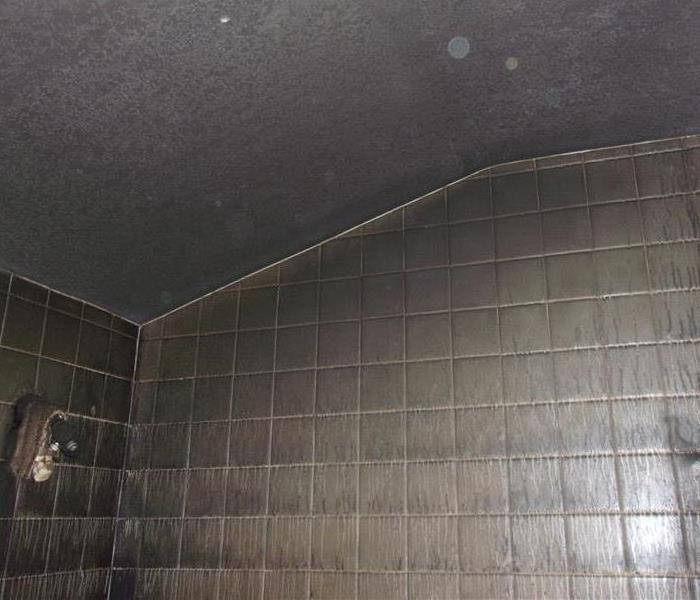 Smoke and soot travel from the origin of fire throughout the structure.
Smoke and soot travel from the origin of fire throughout the structure.
Smoke and soot is very invasive and can penetrate various cavities within your home, causing hidden damage and odor. Our smoke damage expertise and experience allows us to inspect and accurately assess the extent of the damage to develop a comprehensive plan of action.
Smoke and soot facts:
- Hot smoke migrates to cooler areas and upper levels of a structure.
- Smoke flows around plumbing systems, seeping through the holes used by pipes to go from floor to floor.
- The type of smoke may greatly affect the restoration process.
Different Types of Smoke
There are two different types of smoke–wet and dry. As a result, there are different types of soot residue after a fire. Before restoration begins, SERVPRO of Benicia/Martinez/Southeast Vallejo will test the soot to determine which type of smoke damage occurred. The cleaning procedures will then be based on the information identified during pretesting. Here is some additional information:
Wet Smoke – Plastic and Rubber
- Low heat, smoldering, pungent odor, sticky, smeary. Smoke webs are more difficult to clean.
Dry Smoke – Paper and Wood
- Fast burning, high temperatures, heat rises therefore smoke rises.
Protein Fire Residue – Produced by evaporation of material rather than from a fire
- Virtually invisible, discolors paints and varnishes, extreme pungent odor.
Our Fire Damage Restoration Services
Since each smoke and fire damage situation is a little different, each one requires a unique solution tailored for the specific conditions. We have the equipment, expertise, and experience to restore your fire and smoke damage. We will also treat your family with empathy and respect and your property with care.
Have Questions about Fire, Smoke, or Soot Damage?
Call Us Today – 925-372-7234
Benicia/Martinez/SE Vallejo
7/13/2016 (Permalink)
Smoke and soot is very invasive and can penetrate various cavities within your home, causing hidden damage and odor. Our smoke damage expertise and experience allows us to inspect and accurately assess the extent of the damage to develop a comprehensive plan of action.
Smoke and soot facts:
- Hot smoke migrates to cooler areas and upper levels of a structure.
- Smoke flows around plumbing systems, seeping through the holes used by pipes to go from floor to floor.
- The type of smoke may greatly affect the restoration process.
Different Types of Smoke
There are two different types of smoke–wet and dry. As a result, there are different types of soot residue after a fire. Before restoration begins, SERVPRO of Benicia/Martinez/Southeast Vallejo will test the soot to determine which type of smoke damage occurred. The cleaning procedures will then be based on the information identified during pretesting. Here is some additional information:
Wet Smoke – Plastic and Rubber
- Low heat, smoldering, pungent odor, sticky, smeary. Smoke webs are more difficult to clean.
Dry Smoke – Paper and Wood
- Fast burning, high temperatures, heat rises therefore smoke rises.
Protein Fire Residue – Produced by evaporation of material rather than from a fire
- Virtually invisible, discolors paints and varnishes, extreme pungent odor.
Our Fire Damage Restoration Services
Since each smoke and fire damage situation is a little different, each one requires a unique solution tailored for the specific conditions. We have the equipment, expertise, and experience to restore your fire and smoke damage. We will also treat your family with empathy and respect and your property with care.
Have Questions about Fire, Smoke, or Soot Damage?
Call Us Today – 925-372-7234





 24/7 Emergency Service
24/7 Emergency Service
